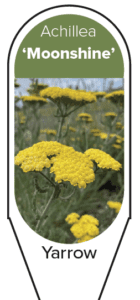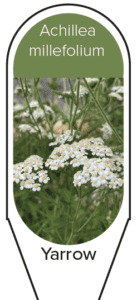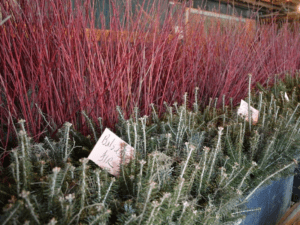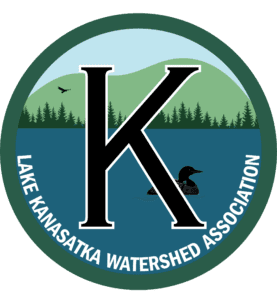How Do I Buy Native Plants?
Some of you may be veteran gardeners and others may be new to the idea of planting things in your yard. There are many rewards to growing things, but also many challenges. The challenge is greater if you have resolved to work with native plants because they can be hard to find.
Garden centers and nurseries, like other retail businesses, are in the business of selling things, and they work hard to lure you in. Often the flashiest or most colorful plants are situated right at the entrance where they will tempt you to make impulse buys. They are most likely NOT native plants. It is important to do your research ahead of time and know what you are looking for. It is a good idea to keep a list on your phone so you can refer to it as you wander around a nursery.
Many garden centers focus on familiar annuals and perennials that are not native. A very few carry native plants. And even fewer specialize only in native plants. Be sure to advocate for natives with garden center staff

Cultivar of a native plant. Name will have quotation marks. Try to avoid cultivars or nativars.
wherever you go.

Straight species native plant. Buy straight species wherever possible.
Nurseries are starting to provide more native plants, but the trend is for them to sell cultivars.
They can make the most money selling “enhanced” versions. You will see lots of plants labeled “native” that are actually “cultivars” or “nativars.” While not all bad, these tend to be not as good as buying a true native plant. Often a cultivar is bred to create different bloom shape, color, scent, or plant size. New traits, while they may be aesthetically pleasing to humans, can make the plants less appealing to the pollinators that are hard-wired to the native plants. A “nativar” is a nursery trade-invented term for a native cultivar.
When you are at the nursery, how do you tell if a plant is native? It’s all in the plant names and labels and you’re going to need to learn a little botanical Latin! Plants have many common names, which can vary from region to region and thus be confusing. The only way to be sure of a plant ID is to use the Latin or binomial name, with a genus name listed first followed by a specific epithet. Combined, these two terms are called the species name.
Let’s use a favorite shrub, summersweet or sweet pepperbush, as an example. Its species name is Clethra alnifolia. It grows around 5-7’ tall, will grow in full sun to total shade, but will grow best in light, dappled shade, or with morning sun and afternoon shade. The blooms have a wonderful scent. Because of their tolerance for moist soils, they can be used for lakefront erosion control and rain gardens.
So look for a plant label that just says Clethra alnifolia. This is the true native. If it is a cultivar, it will have a third name in quotes, for example, Clethra alnifolia ‘Ruby Spice’ which was bred to have a different bloom color. Another dead giveaway–if it is in a pot branded “Monrovia”, or “Proven Winners”– you can bet that it is a cultivar created by the wholesale nursery trade.
Additional Resources about the Native Plant Nursery Trade
- Plant Terminology, Native vs. Naturalized, Hybridization, Cultivars—Grow Native Massachusetts
- Navigating the Nurseries: A Resource Guide—Wild Seed Project
- How to Buy Native Plants—National Audubon Society
- Flower Power—Cultivars vs. Straight Species—The Humane Gardener[/fusion_text]
Where Do I Buy Native Plants

New Hampshire State Forest Nursery, Concord NH.
Purchasing native trees and shrubs can be challenging due to availability and cost. One terrific solution for native trees and shrubs is the New Hampshire State Forest Nursery, which meets both those challenges. The Nursery usually publishes its spring online sales catalog in December each year.
They sell small bare root native trees and shrubs in bundles of ten for around $15 per bundle. If 10 plants seem like too many, share with a neighbor. If you are trying to create a thicket of shrubbery, individual shrubs should be spaced, as a general rule, around 3’ apart. This will help you calculate how many plants you need.
In contrast, individual shrubs from a local nursery are likely to cost more than $50 each! So ordering from the NH State Forest Nursery is an incredibly cost-effective way to fill in your waterfront buffers and rain gardens. The plants are small bare-root seedlings–so this route involves patience. Shrubs will take several years to attain full size. And trees take even longer—but you are planting now for future generations.
The Nursery provides several options for picking up the plants in April or May, or you can have them shipped to you for a nominal fee. You will need to be ready to either plant them right away when they arrive, or put them into pots to hold until you are ready to plant later in the spring. This means some pre-planning so you have pots and potting soil available. You’ll need to make sure the pots don’t dry out. Once planted, the small seedlings will need watering regularly in the first and possibly second year (if we don’t have rain) to get established, but after that they should be care free.
Do your research and dreaming now and decide what you would like to plant so you are ready to order when the catalog becomes available each December. They sell out fast. You can go to the website now and look at what they are selling this season, but many plants may have already sold out. Make notes for next year.
Local Sources of Native Plants
A recent check of what was being sold at Stephens Landscape Center and Aubuchon Hardware, both in Moultonborough, revealed quite a few native cultivars but few true native plants for sale. Push them to stock more true natives! Both businesses have had fall sales with significant discounts in past years. You can check other local nurseries and may find a few native plants, primarily perennials. But no one specializes in only natives and you will need to do your research in order to avoid buying cultivars or non-natives.
Wild Seed Project has a web page that is searchable for native plant nurseries and plant sales by state.
In-State Resources:
- Bagley Pond Perennials (Warner, NH)
- Found Well Farm (Pembroke, NH)
- NH Native Perennials (Madison, NH)
Out-of-State Sources:
- Wild Seed Project (Yarmouth, ME)
- Native Plant Trust (Framingham, MA)
- Blue Stem Natives, (Norwell, MA)
- Prairie Moon Nursery, (Winona, MN)
